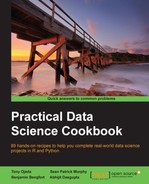We have already pointed out that companies such as Amazon track purchases and page views to make recommendations, Goodreads and Yelp use 5 star ratings and text reviews, and sites such as Reddit or Stack Overflow use simple up/down voting. You can see that preference can be expressed in the data in different ways, from Boolean flags to voting to ratings. However, these preferences are expressed by attempting to find groups of similarities in preference expressions in which you are leveraging the core assumption of collaborative filtering.
More formally, we understand that two people, Bob and Alice, share a preference for a specific item or widget. If Alice too has a preference for a different item, say, sprocket, then Bob has a better than random chance of also sharing a preference for a sprocket. We believe that Bob and Alice's taste similarities can be expressed in an aggregate via a large number of preferences, and by leveraging the collaborative nature of groups, we can filter the world of products.
We will model preference expressions over the next few recipes, including:
- Understanding the data
- Ingesting the movie review data
- Finding the highest rated movies
- Improving the movie rating system
A preference expression is an instance of a model of demonstrable relative selection. That is to say, preference expressions are data points that are used to show subjective ranking between a group of items for a person. Even more formally, we should say that preference expressions are not simply relative, but also temporal—for example, the statement of preference also has a fixed time relativity as well as item relativity.
While it would be nice to think that we can subjectively and accurately express our preferences in a global context (for example, rate a movie as compared to all other movies), our tastes, in fact, change over time, and we can really only consider how we rank items relative to each other. Models of preference must take this into account and attempt to alleviate biases that are caused by it. The most common types of preference expression models simplify the problem of ranking by causing the expression to be numerically fuzzy, for example:
- Boolean expressions (yes or no)
- Up and down voting (such as abstain, dislike)
- Weighted signaling (the number of clicks or actions)
- Broad ranked classification (stars, hated or loved)
The idea is to create a preference model for an individual user—a numerical model of the set of preference expressions for a particular individual. Models build the individual preference expressions into a useful user-specific context that can be computed against. Further reasoning can be performed on the models in order to alleviate time-based biases or to perform ontological reasoning or other categorizations.
As the relationships between entities get more complex, you can express their relative preferences by assigning behavioral weights to each type of semantic connection. However, choosing the weight is difficult and requires research to decide relative weights, which is why fuzzy generalizations are preferred. As an example, the following table shows you some well-known ranking preference systems:
|
Reddit Voting |
Online Shopping |
Star Reviews | |||
|---|---|---|---|---|---|
|
Up Vote |
1 |
Bought |
2 |
Love |
5 |
|
No Vote |
0 |
Viewed |
1 |
Liked |
4 |
|
Down Vote |
-1 |
No purchase |
0 |
Neutral |
3 |
|
Dislike |
2 | ||||
|
Hate |
1 |
For the rest of this chapter, we will only consider a single, very common preference expression: star ratings on a scale of 1 to 5.
